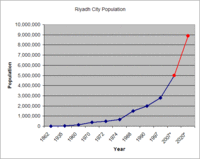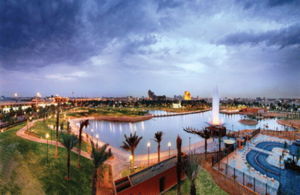Riyadh
2007 Schools Wikipedia Selection. Related subjects: Geography of the Middle East
| Riyadh City الرياض |
|
| Looking at the Kingdom Tower from Al Faisaliyah. | |
| Location in the Kingdom of Saudi Arabia | |
| Coordinates: | |
|---|---|
| Province | Ar Riyad |
| Prince | Salman bin Abdul Aziz |
| Area | |
| - City | 1,554 km² |
| - Land | 1,554 km² |
| - Water | 0 km² |
| Population | |
| - City (2005) | 4,260,000 |
| - Metro | 5,514,000 |
| Website: City of Riyadh | |
Riyadh (Arabic: الرياض ar-Riyāḍ) is the capital and largest city of the kingdom of Saudi Arabia, located in Ar Riyad Province in the Najd region. It is situated in the centre of the Arabian peninsula on a large plateau and is home to over 4,260,000 people (around 20% of the nation's population).
The city lies in Saudi Arabia's 'central corridor' of development along with Buraydah and Al Kharj in the Ar Riyad administrative division. The other areas of concentrated population are two coastal areas - around Jiddah and Mecca on the Red Sea, and around Jubail and Dhahran on the Persian Gulf. Riyadh is located at 24°42'42" North, 46°43'27" East (24.711667, 46.724167).
The city is divided into 17 branch municipalities under the control of the Riyadh Municipality and the Riyadh Development Authority, chaired by Riyadh Province Governor Prince Salman Bin Abdul Aziz.
Although in a highly arid area the city does receive some rainfall. Five dams store the runoff. There are also 96 wells and 290 miles (467 km) of pipe bringing huge volumes of water from desalination plants on the Persian Gulf.
Name
The name Riyadh is derived from the Arabic word meaning a place of gardens and trees ("rawdah"). With many wadis (a former water course, now dry) in the vicinity, Riyadh has been since antiquity a fertile area set in the heartland of the Arabian peninsula.
History
In pre-Islamic times, the settlement at the site was called Hajar. The site is at the confluence of several rivers (now wadis) and much underground water is accessible at the site. The settlement was historically famous for its dates and orchards. The modern name was first applied to only certain parts of the settlement where orchards predominated. Gradually the name was used for the entire settlement.
By the end of the 18th century, Riyadh was part of the First Saudi State, with the capital at Diriyah. After the destruction of Diriyah in 1818 by the Turks, the capital moved to Riyadh. Portions of Diriyah, a city made of mud bricks, still exist.
The city was seized in 1902 by Abdul Aziz bin Abdul Rahman Al Saud. He went on to establish the modern Kingdom of Saudi Arabia in 1932, with Riyadh the capital of the nation. The diplomatic capital remained at Jeddah until 1982. Recently the city has experienced very high rates of population growth, which is indicated by the poor quality of development since the 1970s. In the 1960s, its population was 50,000. According to most recent sources, today it is home for over 4.5 million inhabitants.
Population
| Year | Population |
|---|---|
| 1862 | 7,500 |
| 1935 | 30,000 |
| 1960 | 150,000 |
| 1970 | 370,000 |
| 1972 | 500,000 |
| 1974 | 650,000 |
| 1988 | 1,500,000 |
| 1990 | 2,000,000 |
| 1997 | 2,800,000 |
| 2007* | 5,000,001 |
| 2020* | 8,900,000 |
*Estimate
Between 1974 and 1992 the city grew by an average of 8.2% per year.
City districts
Once a small walled city, Riyadh has developed into a dynamic metropolis over the years. The first major thrust came during the oil boom of the 1950s, when older structures were demolished to make way for commercial development. Today, it is one of the fastest growing and most prosperous cities in the world.
The capital and largest city of the Kingdom, Riyadh is divided into 17 municipalities. Each contributes in its own way to the vibrant character of the city, which boasts of a fairly unique history and colorful past. The city has grown both culturally and commercially over the years. Along with the urban areas of Dhahran, Dammam, and Al-Khobar, Riyadh has become a focal point for both travel and trade. On the outskirts of the city lies the ancient town of AI-Dih'yah.
In addition to being the centre of power, the city is also a commercial hub. Numerous educational, financial, agricultural, cultural, technical, and social organizations have set up base here. The most striking aspect of Riyadh is its architecture, which is a vibrant juxtaposition of the old and the new - contemporary high-rises tower over buildings exuberating of old world charm.
The bustling Olaya District is the heart and soul of this city. This commercial and residential district offers accommodation, entertainment, dining and shopping options. The Kingdom Centre, Al Faisalyah and Al-Tahlya street the areas' landmarks.
The centre of the city, Al-Bathaa, is also its oldest part. At its heart lies the beautiful 19th-century Masmak Castle, which is one of the city's major attractions; and to the west lies the Riyadh Museum of History and Archeology.
The Diplomatic Quarter or DQ as it is popularly known, is home to foreign embassies, international organizations as well as residential structures and malls. With lush gardens and numerous sports facilities, it is also one of the city's greenest areas. It is especially known for its fine architecture, and is considered a model for other Islamic cities around the world. Despite its name, the Diplomatic Quarter offers no special privileges. All Saudi laws must be obeyed and there are occasional patrols by the Mutaween, or Saudi religious police.
The Qasr Al-Hukm or the Justice Palace is located in the district of the same name. It is here that the Governor meets citizens and listens to their grievances and problems and stays abreast to all aspects of the region's life. Its architecture, like other buildings in the area, is a fine mélange of traditional and contemporary styles.
While the Al Khobar District is a preferred residential choice for expatriates, the Al-Dira area is rich with commercial markets and traditional buildings, which include the famous Royal Palace and Al-Mue'qila building.
Numerous shops, lively markets, world-cuisine restaurants, and huge malls keep both Salahuddin District and King Fahad highway packed with tourists.
Noted structures
- The Riyadh TV Tower is a 170 metre high television tower with an observation deck at Riyadh, Saudi Arabia. The Riyadh TV Tower was built between 1978 and 1981
- The Al Faisaliyah Centre was the first skyscraper constructed in Saudi Arabia, and the second tallest building in the country after the Kingdom Center. The golden ball that lies atop the tower is said to be inspired by a ballpoint pen. Inside the ball is a restaurant; at ground level, a shopping centre with major world brands
- Kingdom Centre: Current tallest building in Saudi Arabia
- Al Rajhi Tower: Tallest building in Saudi Arabia when completed in 2009
- King Khalid International Airport
- King Fahd Stadium
- Masmak Castle
Major areas include Olaya, in downtown, Dabab, near the Old Airport ( King Fahd Airbase) and Batha, the old downtown part of the city.
Tourism
Sites to visit in Riyadh are limited, but include the following:
- Masmak Castle, a fort in Riyadh famous for King Abdulaziz Al Saud's daring raid on the fort in 1902
- King Fahd Cultural Centre, located outside of town, the cultural centre has a planetarium, museum, library, and three theaters
Trivia
Riyadh was mentioned in the 1999 comedy film Office Space:
- Peter Gibbons: "Samir, this is America. This isn't Riyadh; they're not going to saw your hands off."
Gallery
|
Family entertainment club |
Tuwaiq Palace |





